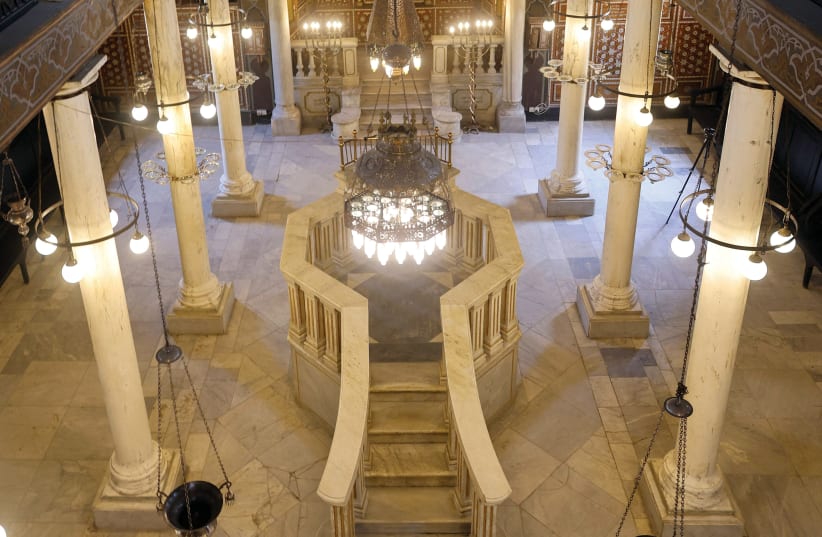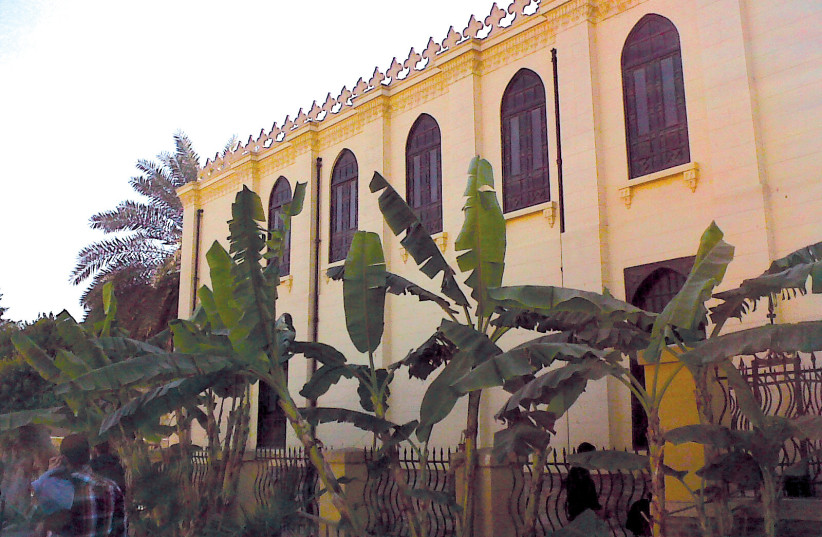Seeking to broaden its tourist market beyond the splendor of its pharaonic and Islamic civilizations, Egypt is investing tens of millions of Egyptian pounds to preserve the country’s rich Jewish and Christian past. In doing so, it has stumbled into a minefield about memory.
On August 16, in celebration of the annual Fast of the Virgin Mary, a 10-ton, nine-meter tall bronze statue of the mother of Jesus was dedicated at a Coptic monastery in Asyut, 400 km. south of the capital. This was followed on August 31 by the unveiling in Fustat (Old Cairo) after a year-long restoration of the 12-century-old Ben Ezra Synagogue, and on September 15 by Rosh Hashanah services held at Heliopolis’ Vitali Madjar Synagogue – the first such Jewish New Year celebration held in Cairo in 70 years.
The historic synagogue is located within the ancient Roman Babylon Fortress in medieval Fustat. It adjoins the 10th-century Greek Orthodox Church of St. George and the Coptic Church of St. Mary, sometimes called the Hanging Church. The synagogue, named after the Tudela, Spain-born Torah commentator and philosopher Abraham Ibn Ezra (c. 1089 / 1092 – c. 1164 / 1167), was once home to the storied Cairo Geniza.
The renovation received considerable media attention. Egyptian Prime Minister Mostafa Madbouly inaugurated the restored building. Also in attendance were Cairo’s governor Khaled Abdel-Aal Abdel-Hafez and the country’s ministers of tourism and antiquities, and of local development.
None of Egypt’s tiny community of Jews – six live in Cairo, while a few dozen reside in Alexandria – were invited.
“The synagogue is one of the most important and oldest Jewish temples in Egypt, housing numerous valuable books about the customs, traditions, and social life of the Jewish community in Egypt,” declared Tourism and Antiquities Minister Ahmed Issa. The synagogue’s ceiling was reinforced to prevent its collapse, he said in a statement. Additionally, the structure was insulated, its lighting system updated, and its marble columns cleaned, he noted.
Issa may have misunderstood the true breadth of the Cairo Geniza. Since 1896, that priceless collection of 400,000 Hebrew, Aramaic, and Arabic manuscript fragments and Fatimid administrative documents has been housed at various elite cultural institutions in Britain, France, Russia, Hungary, and the United States, including the Cambridge University Library outside London, the Bodleian Library in Oxford, and the Jewish Theological Seminary in New York. The trove warehoused for centuries in the attic of the Ben Ezra Synagogue was the primary source for S.D. Gotein’s magisterial six-volume A Mediterranean Society: The Jewish Communities of the Arab World as Portrayed in the Documents of the Cairo Geniza.
However laudable the recent restoration in Fustat, and regrettable that Issa and Madbouly seemingly misunderstood the significance of the Cairo Geniza, they also failed to acknowledge the 11 years from 1980 to 1991 and great expense which Montreal architect and philanthropist Phyllis Lambert invested in restoring that house of worship. Those efforts, documented in the 1994 book Fortifications and the Synagogue: The Fortress of Babylon and the Ben Ezra Synagogue, Cairo, which Lambert edited, have seemingly been written out of history.
A letter from Manfred R. Lehmann of Miami Beach, Florida, to The New York Times on September 10, 1995, provides some context:
To the Editor:
Phyllis Bronfman Lambert’s project that would restore the 1,000-year-old Ben Ezra Synagogue in old Fostat, the city that existed before Cairo was founded, is laudable.
When I first traveled to Cairo as a guest of President Anwar Sadat, a visit to the Ben Ezra Synagogue was on every tour company’s program. The restoration of the dilapidated shrine of Jewish worship was certainly necessary. But tragically it has become a victim of the “peace” process in that Egypt is in the shadow of Islamic fundamentalism, where no interfaith activity can be tolerated.
Hence, Ms. Lambert’s dream of establishing an interfaith center in the Ben Ezra Synagogue is a nonstarter in today’s atmosphere, which is hostile to any “infidel” activity, Jewish or Christian. Thus, tours have dropped visits to the synagogue, and even taxi drivers have refused to take tourists there.
Let us hope that a spirit of religious tolerance will return to Egypt and the Arab world so true peace can reign.”
To understand how Lambert has been white-washed from the credit she deserves, one has to delve into Canadian Jewish history.
Born in 1927, Lambert was the second daughter of Montreal’s notoriously cantankerous whiskey baron Samuel Bronfman (1889-1971), who bragged that he gave ulcers rather than suffered from them. The surname means “distiller” in Yiddish, suggesting the family was in the booze biz before crossing the Atlantic.
While the Prohibition lasted from 1920 to 1933 in the US, Canada’s province of Quebec repealed the wartime liquor ban in 1919. Bronfman made a fortune exporting his legally distilled whiskey to France’s rocky outpost of St. Pierre et Miquelon near the British colony of Newfoundland. Gangsters like Al Capone then smuggled the contraband into American ports.
Bronfman’s desire to shed his bootlegger past and gain respectability weighed heavily on his children. Phyllis chafed under her father’s watchful eye. The disharmony grew worse in 1949 when Lambert made the cardinal sin of marrying a non-Jew – Jean Lambert, a French-German economic consultant. When the couple divorced in 1954, Lambert remained in Paris, where she pursued her career as an artist far away from the wrath of her father.
That year she wrote him an eight-page letter urging him to rethink his plans for a skyscraper to serve as headquarters for The Seagram Company Ltd. Mr. Sam, having transitioned to an international businessman, wanted a prestigious Manhattan address to house his diversified conglomerate of liquor, real estate, oil and gas, and chemical companies – and reflect his status.
Bronfman agreed, and Lambert devoted herself to the Seagram Building project. She persuaded her father to hire “less is more” architect Mies van der Rohe to design the tower at 375 Park Avenue, which became an immediate International Style modernist landmark. Van der Rohe became Lambert’s mentor, and she studied architecture. After graduating from Chicago’s Illinois Institute of Technology, her family commissioned her in 1967 to design an arts complex for Montreal’s Jewish community. Known as the Saidye Bronfman Centre (today renamed The Segal Centre for Performing Arts), in honor of her mother. Lambert’s design, with its elegant glass curtain walls, was a tribute to Van der Rohe.
Following the death of her father, relations became further strained between Lambert and her siblings Edgar Bronfman (1929–2013), Charles Bronfman (b.1931), and Minda de Gunzburg (1925-1985). Apart from her monumental task of restoring Cairo’s decrepit Ben Ezra Synagogue, Lambert had no further involvement in Jewish life.
Arguably, her proudest achievement was her leadership role in founding the Canadian Centre for Architecture in Montreal in 1979, one of the world’s leading architectural museums, to which she donated 750,000 shares of Seagram stock.
The following year, she undertook to restore the Ben Ezra Synagogue which had fallen into abject disrepair. Completed in 1991, her work restored the house of worship to a grandeur worthy of medieval Cairo.
Lambert was made a member and subsequently an officer of the Order of Canada – the country’s highest civilian honor. And in 1991, she received the Gold Medal from the Royal Architecture Institute of Canada, the country’s most prestigious architectural award. ■
Mideast’s tallest statue of Virgin Mary dedicated in Egypt
The Middle East’s tallest statue of the mother of Jesus was dedicated recently at the Virgin Mary Monastery in Durunka, near Asyut, Egypt 390 km. south of Cairo. Standing nine meters (28 feet) tall atop a 15-meter-high (46 foot) pedestal, the bronze is the work of sculptor Gerges al-Gawly – formerly the head of the Sculpture Department at the nearby Minia University.
The mammoth instant landmark, inspired by ‘Our Lady of Lebanon’ in Harissa east of Beirut, was commissioned by Bishop Yoanes of Asyut. It recalls the apparition of the Virgin Mary on August 17, 2000 at St. Mark’s Church in Asyut, which was validated that month by Coptic Pope Shenouda III.
While the preparation of the statue took two years, the statue itself was fashioned in three months. The 20 sections were transported from a foundry in Cairo to Asyut. It was assembled on site to mark the start on August 7 of the Coptic Orthodox Fast of the Virgin. During the 15-day celebration, the 11 million Copts in Egypt and their diaspora ask Mary for her intercession throughout the coming year.
Tens of thousands of Coptic pilgrims visit the Virgin Mary Monastery annually. It is one of the final stops in the Holy Family Trail. As recounted in the New Testament, Joseph and Mary fled from Bethlehem with their newborn son to escape the massacre of babies by Herod the Great. They remained in Egypt for three years until they learned that the king of Judea had died, traveling through 11 of Egypt’s modern-day governorates, from North Sinai to Asyut far south in the Nile River Valley.
The Holy Family Trail is currently being developed by the Ministry of Tourism and Antiquities in cooperation with the Ministry of Culture as a means of promoting cultural and religious tourism in Egypt. It involves infrastructure improvements at the 25 sites and shrines at which the Holy Family is believed to have stopped. The trail also symbolizes Egypt’s status as the country in the predominantly Sunni Muslim Middle East with the largest Christian population.

